

The Hôtel de Bordeaux is ideally located in the heart of Charente-Maritime. Its discovery heritage is rich there both in terms of summer activities and in historical, cultural and artistic terms throughout the year. We are at your disposal before and during your stay at the hotel to advise you and help to organize your visits and excursions.
Built on a steep cliff and on the banks of the River Seugne, the medieval town of Pons is located in Haute-Saintonge (Charente-Maritime).
Pons is located 20km south of Saintes, not far from the A10 motorway and the route nationale RN137, 100km north of Bordeaux and 5km from exit 36. Transit to the hotel from Pons train station or Pons-Avy airfield can be arranged.
“If I cannot be King of France, I wish to be Sire of Pons.”
The town of Pons is located on a rocky promontory that dominates the Seugne Valley. From the Neolithic period onwards, settlers have occupied the area to take advantage of its strategic geographical position. The Gauls established an important settlement here before the arrival of the Romans. For three centuries these remained centred around the castrum. It is from this period that Pons derives its name. To cross the marshy valley, the Romans used a system of stilt bridges, the pontes. And although the town’s name is now Pons, the inhabitants are still called the Pontois.
Pons castle dates back to the tenth century. Part of the Duchy of Aquitaine since 1152, Saintonge rebelled against its rulers in 1179. Richard the Lionheart put down the rebellion and destroyed the castle. Geoffroy III, the first of a long dynasty of lords of Pons, hurried to rebuild it. The new dungeon was completed in 1187.
During the Hundred Years’ War, Pons became a strategic border post between Aquitaine and the Kingdom of France. It preserved its heritage by switching from one side to the other. Under Renaud VI, the community reached its peak at the end of the 14th century following significant territorial expansions. From this period comes the popular saying that illustrates the power of the Lords of Pons: “If I cannot be King of France, I wish to be Sire of Pons.”
The Hundred Years’ War ended in 1453 and activity in the town revived. But soon the Wars of Religion raged and the town, which had become a Protestant stronghold in 1621, capitulated without resistance. Thus ended the town’s important military role.
The prestigious dynasty of the Lords of Pons died out in 1586. The Albret family followed and in the 17th century built a manor house on the ruins of the old castle, which today houses the town hall. It then passed into the domain of Lothringen-Marsan until the French Revolution.
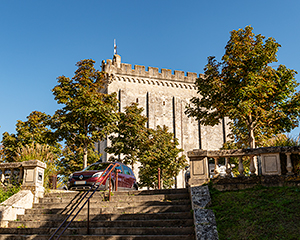
The keep was completed in 1187 by Lord Geoffroy III after the destruction of the first castle by Richard the Lionheart, then Duke of Aquitaine, who had come to put down a rebellion by his Saintonge vassals. This 30-metre-high tower with a square footprint (26m x 15m) and flat buttresses is typical of the “Romanticism of the West” dungeons. It is the last remnant of the medieval fortress, which became a safe place for Protestants after the Edict of Nantes. The town submitted without a fight to the army of Louis XIII in 1621, after which Richelieu ordered the demolition of the castle. Towers and ramparts were razed to the ground, except for the keep, which is one of the best-preserved in the Saintonge.
Its upper end is a 20th-century creation resulting from a somewhat fanciful restoration, as there were originally no battlements, bretèches or watchtowers.
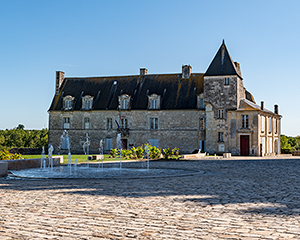
After the turmoil of the religious wars and the demolition of the castle, the powerful Pons dynasty died out and possession passed to a branch of the Albret family. On the foundations of the old castle, Henri I d’Albret had a new manor house (now the town hall) built after 1621. His son Phébus d’Albret, Marshal of France at the Court of Versailles, enlarged this mansion and embellished it with a French garden on the site of the old infilled courtyard (today the public garden). Originally, the town hall and library formed a single main building.
The missing part between the two buildings was destroyed in a fire.
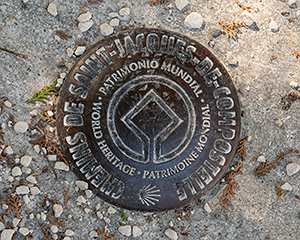
Four main roads lead to Santiago de Compostela: Tours, Vézelay, Le Puy and Arles. Pons is located on the Via turonensis, which used to lead from Tours to Santiago de Compostela. Since the 12th century, the town of Pons was renowned for its warm welcome and as a place of refuge. At that time, the pilgrimage was at its peak and thousands of faithful followed the route. Churches and inns sprung up along this route to cater to the believers.
Saint James was one of the twelve apostles of Christ. At the start of the Christianisation of the Iberian Peninsula in the first century, James the Great was beheaded in Jerusalem by the Roman Emperor of Palestine. According to legend, his body was placed in a stone boat that, guided by God’s hand, crossed the Mediterranean to reach the beaches of Galicia in the northwest of present-day Spain.
St. James is credited with many miracles.
In Pons, the hospice of Saint Nicolas was quickly overwhelmed and was no longer big enough to receive all the poor, sick and orphaned pilgrims of Saint James. Geoffroy III, Lord of Pons, responded by building a second facility, called the “new hospital”, outside the village. He himself was buried there in 1192.
Located on the old road to Bordeaux, the Pons Hospice is the last surviving example of its kind. It combined care of body and soul. A cross-ribbed vault connected the churches in the east (destroyed) and the infirmary in the west. Orphans were housed and the poor received a portion of blessed bread under this porch, which provides protection from sun and rain and used to be surmounted by a tower. Many historical graffiti are engraved there. To the left of the infirmary portal, on one of the capitals, you can make out the town’s famous protective eel if you look carefully. Managed by a community independent of ecclesiastical powers, the hospice was in operation until the 18th century.
This extraordinary place is completed by a garden inspired by medieval medicinal gardens. A hundred medicinal plants grow in four separate sections: for fever, injury, mood afflictions and women’s health.
The Seugne is a placid river that welcomed the first settlers and their herds. The fertile land surrounding it favoured the foundation of a Gallic oppidum (settlement), the importance of which has been demonstrated by archaeological finds. This was long before the arrival of the Romans, who built the town and its first bridges.
These bridges, which were of great strategic importance, open the way to Cognac and Angoulême and gave the city its name, Pontem, which later became Pons. The Seugne supports economic activity such as fisheries, tanneries and mills (fourteen in all). The last mill was in operation until just a few years ago.
Although crenellated aisles were added in the 13th century, St. Vivien retains all the features of the Romanesque style of the Saintonge: two cords divide the facade into horizontal registers and two blind portals frame the central portal with five arches. Decorated with the typical blind arcade of double bays seen on other buildings in the region, it was interrupted in the 16th century by the opening of a Gothic bay. Its originality lies in the four half-columns that divide the facade vertically, a rare arrangement in the Saintonge.
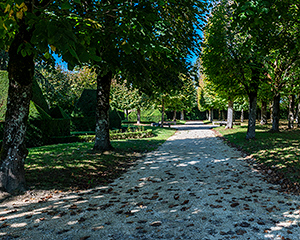
This used to be the main courtyard of the castle. Stripped of its military attributes in 1621, it was levelled in the 17th century by the feudal lord César Phébus d’Albret, who in 1665 built a French garden inspired by Le Nôtre. The garden you see today is the result of a landscaping change that replaced the garden of 1885 and therefore owes nothing to the famous 17th century architect. Walk along the top of the rampart to enjoy the view over the Seugne Valley and admire the magnificent 17th-century staircase. Nearby is the spiral staircase of an old fortified tower, a remnant of the castle destroyed in 1621.
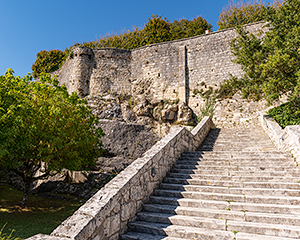
Cesar Phébus d’Albret had this monumental staircase built to provide access to the gardens and orchards. Given the severe topographical constraints, it was a masterly feat by the architect, who designed it so that ascending and descending the 142 steps is a walk in its own right.
The old Church of St. Martin, of which only a few stones remain, was originally built near the cemetery of the same name. For a long time, it was the most important religious building in the region. Although it was destroyed and rebuilt many times (especially during the religious wars), it kept its name throughout its various reincarnations. The present St. Martin’s was consecrated in 1834.
Make sure to pause in this square, dedicated to the 16th-century poet (1552-1630). A few verses honour the writer, who was born in a hamlet not far from here. Known for works such as The Tragics, Universal History, etc. and his martial exploits alongside the Reformists, he was also the grandfather of the very Catholic Marquise de Maintenon, famous mistress of King Louis XIV.